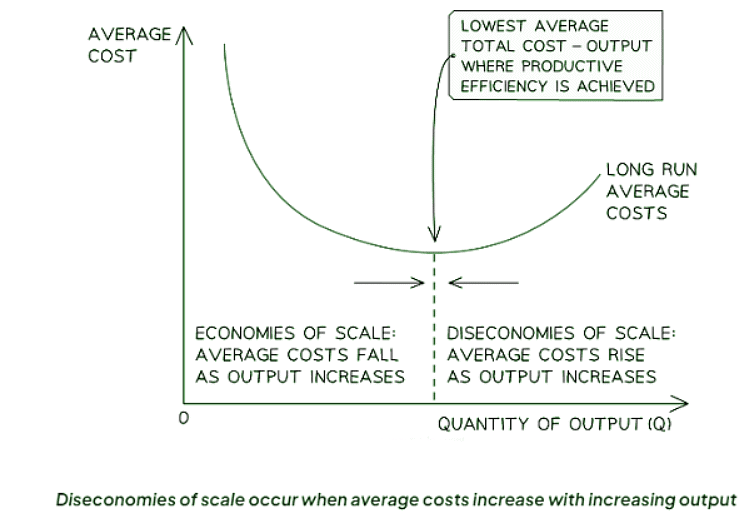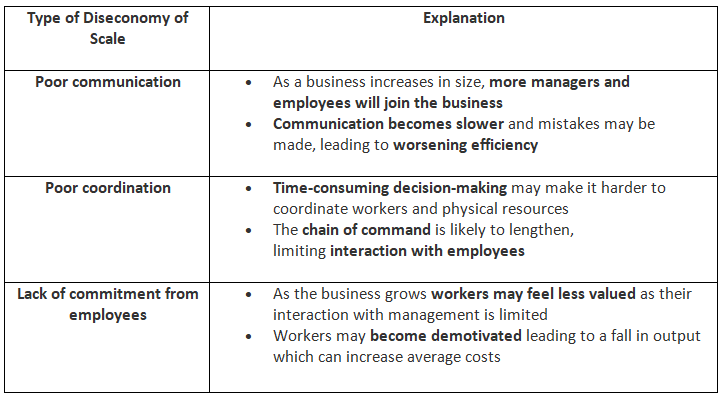Class 10 Exam > Class 10 Notes > Business Studies for GCSE/IGCSE > Diseconomies of Scale
Diseconomies of Scale | Business Studies for GCSE/IGCSE - Class 10 PDF Download
Diseconomies of Scale
- As a company increases its scale of production, it will eventually experience a point where its average costs begin to rise. This increase in average costs is known as diseconomies of scale.
- The term "diseconomies of scale" refers to the situation where the average costs of production increase as the output levels rise.
Diagram: Diseconomies of Scale

Diagram analysis
- A firm reaches a stage where it cannot further decrease costs, known as productive efficiency.
- Beyond this point, average costs start increasing due to diseconomies of scale.
- This signifies the existence of an optimal output level when technology and capital (machinery) are unchanged.
Different Examples of Diseconomies of Scale
- Inefficiency Due to Size: When a business expands excessively, it can become inefficient. For instance, a large corporation may face challenges in communication and coordination, prompting a need to restructure for improved efficiency.
- Organizational Restructuring: Companies experiencing diseconomies of scale often reorganize into smaller autonomous units to enhance communication and operational effectiveness.
Different types of diseconomies of scale
- Diseconomies of scale illustrate that a business may lose efficiency as it grows larger.
- Businesses facing diseconomies of scale might review their organizational structure to address issues with communication and coordination.
- Many exceedingly large businesses opt to divide themselves into smaller autonomous units to enhance communication effectiveness.
Explanation of Diseconomies of Scale
Question for Diseconomies of ScaleTry yourself: What is meant by diseconomies of scale?View Solution
The document Diseconomies of Scale | Business Studies for GCSE/IGCSE - Class 10 is a part of the Class 10 Course Business Studies for GCSE/IGCSE.
All you need of Class 10 at this link: Class 10
|
70 videos|93 docs|26 tests
|
FAQs on Diseconomies of Scale - Business Studies for GCSE/IGCSE - Class 10
| 1. What are some common examples of diseconomies of scale in businesses? |  |
Ans. Some common examples of diseconomies of scale in businesses include communication breakdowns as the company grows larger, increased bureaucracy leading to slower decision-making, difficulty in coordinating operations across different departments, and higher costs due to inefficiencies in production processes.
| 2. How do diseconomies of scale differ from economies of scale? |  |
Ans. Diseconomies of scale refer to the increase in per-unit costs as a company grows larger, while economies of scale refer to the decrease in per-unit costs as a company expands its production. Diseconomies of scale can arise due to inefficiencies in larger organizations, whereas economies of scale result from cost savings from increased production levels.
| 3. How can businesses mitigate the impact of diseconomies of scale? |  |
Ans. Businesses can mitigate the impact of diseconomies of scale by investing in technology to improve operational efficiency, streamlining decision-making processes to reduce bureaucracy, implementing cross-functional teams to enhance coordination, and regularly evaluating and optimizing production processes to eliminate inefficiencies.
| 4. What are the potential consequences of ignoring diseconomies of scale in a business? |  |
Ans. Ignoring diseconomies of scale in a business can lead to increased costs, reduced profitability, decreased competitiveness in the market, lower employee morale due to inefficiencies, and difficulties in adapting to changing market conditions. It is essential for businesses to address diseconomies of scale to ensure long-term success.
| 5. How can businesses identify if they are experiencing diseconomies of scale? |  |
Ans. Businesses can identify if they are experiencing diseconomies of scale by monitoring key performance indicators such as rising per-unit costs, declining productivity levels, increasing employee turnover rates, customer complaints related to service quality, and delays in decision-making processes. Regularly analyzing these factors can help businesses identify and address diseconomies of scale.
Related Searches
















